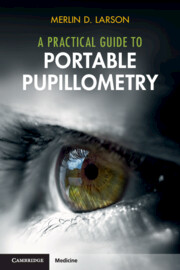Book contents
- A Practical Guide to Portable Pupillometry
- Reviews
- A Practical Guide to Portable Pupillometry
- Copyright page
- About the Author
- Contents
- Preface
- Acknowledgements
- Glossary
- Introduction
- Chapter 1 Early History of the Pupil
- Chapter 2 Anatomy of the Pupil
- Chapter 3 Physiology of the Pupil
- Chapter 4 Pharmacology of the Pupil
- Chapter 5 Unusual Pupillary Syndromes
- Chapter 6 Measurement of the Pupil
- Chapter 7 Pupil Size
- Chapter 8 Pupillary Light Reflex
- Chapter 9 Pupillary Reflex Dilation
- Chapter 10 Measuring Inhibition at the EW Nucleus
- Chapter 11 Traumatic Brain Injury, Cardiac Arrest, Intensive Care
- Chapter 12 Opioid Effect and Acute Pain
- Chapter 13 Anisocoria
- Chapter 14 Case Reports
- Conclusion
- References
- Index
- References
References
Published online by Cambridge University Press: 14 November 2024
- A Practical Guide to Portable Pupillometry
- Reviews
- A Practical Guide to Portable Pupillometry
- Copyright page
- About the Author
- Contents
- Preface
- Acknowledgements
- Glossary
- Introduction
- Chapter 1 Early History of the Pupil
- Chapter 2 Anatomy of the Pupil
- Chapter 3 Physiology of the Pupil
- Chapter 4 Pharmacology of the Pupil
- Chapter 5 Unusual Pupillary Syndromes
- Chapter 6 Measurement of the Pupil
- Chapter 7 Pupil Size
- Chapter 8 Pupillary Light Reflex
- Chapter 9 Pupillary Reflex Dilation
- Chapter 10 Measuring Inhibition at the EW Nucleus
- Chapter 11 Traumatic Brain Injury, Cardiac Arrest, Intensive Care
- Chapter 12 Opioid Effect and Acute Pain
- Chapter 13 Anisocoria
- Chapter 14 Case Reports
- Conclusion
- References
- Index
- References
- Type
- Chapter
- Information
- A Practical Guide to Portable Pupillometry , pp. 126 - 143Publisher: Cambridge University PressPrint publication year: 2024

